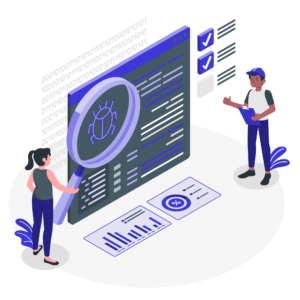A start from scratch article about BDD, and with 100% certainty, we’ll leave you with to the point knowledge first and its history at the end. Do consider reading this if you apply agile principles and frequently run into situations where your team’s efforts and outcomes don’t match at all.
Consider if your investment and time are going blunt. And consider if you think smart technology and communication can fix big problems for good. Not magic but straightforwardly, a better plan to meet your business needs in a short span with top-notch quality. Please keep reading to find out what is BDD is and its magic. (magic not magic)
BDD is a mechanism for fostering collaboration and discovery through examples.
– Dan North
What is the BDD framework?
BDD is Behavioral-Driven Development, a sublime successor of the very famous Test-Driven Development (TDD) thanks to the waving technology. Well, BDD is like an early open conversation with examples among a highly talented, invested, and apparent team of yours (Developers, QA, non-technical, business participants, and more).

Generally, these talks are all about breaking and jotting down the features into stories, acceptance criteria, and tasks. It’s an affable in-house collaboration that leads to outstanding business growth, which is why they are always in buzz.
What is the BDD testing used for?
Around 44% of participants, all business professionals (403 in number) in research conducted by the Economic Intelligence Unit, believe that poor communication is a real villain (hurdle) in business.
That’s true, indeed! Because ineffective communication among any team becomes an immediate negative set back for the entire organization. Here, for instance, the engineers sometimes misunderstand the actual business, and the business professionals doubt the engineers’ capabilities so on and so forth. Like this, several companies pay a hefty price for vague project development and impeded product delivery due to poor communication. BDD aims to change this. Not only does BDD streamlines the requirements process, but it brings the value of QA to the beginning of the development.
What is the BDD approach with examples?
It starts with a natural plain text language to create examples or scenarios in a structure called Given, When, and Then. This structure makes the stated examples executable and the Gherkin scripting language understandable by everyone in the team. More importantly, this process bridges the world of programming and the world of natural language requirements. It also allows different team professionals to be on the same page; we mean, rightly.
Here they mostly discuss how the software should work, how it shouldn’t work, what to test, what not to test, how much to test, what to call the test, and how to determine how a test fails? Look at the below example to get an idea of what is Given, When and Then approach. Let’s take a prevalent example of a login page and the dashboard. Here it goes.
Examples:
Scenario 1:
Given am on the login page.
When I attempt to login with valid login credentials.
Then I am shown the application dashboard.
Scenario 2:
Given am on the login page.
When I attempt to login with invalid credentials.
Then I am shown a login error message.
Note:
- It is a development that makes use of a simple, domain-specific scripting language (DSL)
- The BDD feature file can consist of one or more scenarios. (as you can that in the above example)
- These scenarios are just examples of how the features should work from the standpoint of a user.
- Behind the scenes, the BDD framework will match this natural language to the code that developers write to follow those steps.
- Suppose if this documentation gets out of date, then very certainly something will break in your testing.
- It is a lot of hard work and requires plenty of discipline all across the development team, and the results can be visible and amazing.
What is BDD in Agile?
In the Agile world, the requirements are expressed as stories. These stories usually sit in Jira or similar kind of story repository tools. Each story comprises some acceptance criteria which are put in by the Product Owner or the Business Analysts.
Further, the tests should be against the acceptance criteria and should flawlessly match the code while testing. There are many easy to use plugins that can pull the acceptance criteria from Jira or any tool. Then run those corresponding test cases once the code is complete and develop the test cases. This way, if we miss a requirement while testing, you’ll be aware immediately.
These plugins will complain and right away show you that a particular acceptance criteria doesn’t even have a test. And if somebody accidentally changes something in the code and the test fails, you’ll have a huge regression suite at some point to save you. If you are looking for a tool that takes care of BDD, you need to start it here by signing up for QA Touch. It’s free.
What is the difference between BDD and TDD?
TDD is where you first prepare the tests and then check the functionality’s execution, but they set false results as the code advances in the process. That’s why we have BDD, an improved version of TDD but differs by testing the behavior of the application or software from a user’s point of view.
BDD directly links the specification with the tests written, unlike the TDD. BDD is famed in the software industry for its time-saving nature, and it additionally complements the software with exalted quality. TDD misses business-related aspects, but BDD collaborates and brings everything (innovation, engineering, business, and growth) under one best roof.
We also recently hosted an insightful session on BDD and TDD, where you can find bountiful knowledge and beyond about vast industry concepts. You can also get to be a part of our community too. Just register here now.
A brief history of BDD
Dan North is the originator of BDD (in 2006), a current software vogue word in the spotlight. He placed the specifications upfront on a broad level through business behavior (user is the central here). He owns his consultancy firm named “Dan North & Associates.” He trains professionals and enthusiasts on software delivery and organizational change. And the rest is all business fascination and evolution for BDD and continuing pretty well.
If you need any help in creating a BDD test case, we are sure to help at any time.
Well, well, that’s all for now from us. But you can keep reading more and more of such interesting concepts as long as you want right here. If you like reading about testing and technology and want to add awesome things to your inbox, click here. We write untiring content every week that’ll make go, wow!









